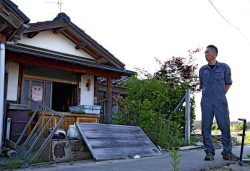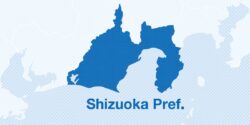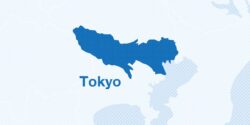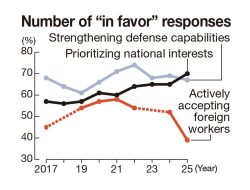
Masanobu Hagiike, left, advises a man to drink warm tea to prevent dehydration, during a medical exam in Suzu, Ishikawa Prefecture, on Jan. 23.
18:34 JST, January 29, 2024
Doctors registered as reserve members of the Self-Defense Forces have helped provide relief in areas hit by the Noto Peninsula Earthquake. One such doctor is Masanobu Hagiike, 55, a surgeon who also helped relief efforts after the 1995 Great Hanshin Earthquake and the 2011 Great East Japan Earthquake.
Having completed his mission in Ishikawa Prefecture and returned to his job at Kagawa University, Hagiike is now passing on the lessons he learned from disaster response to younger doctors. But he still worries about people who have to spend a cold winter on the Noto Peninsula.
SDF reservists, who during normal times work at companies or go to school, are called up during emergencies to provide logistical support and work in disaster-stricken areas. Reservists include former SDF members and those who have passed a special exam and completed training.
The reservists are recruited through public screening. There is also a framework to recruit people with medical, legal and language skills from the public.
On Jan. 23, Hagiike, using a stethoscope, gently asked Shokichi Ibata, 79, who was concerned about his blood pressure and swollen feet, if he was anemic, felt dizzy, or had pain in his throat, at a day care facility in the Kitagata district of Suzu, Ishikawa Prefecture. Roads in the neighborhood were cracked, with snow piled up on either side. Several manhole shafts had been pushed up out of the ground.
“I feel much better now that I’ve been examined by a doctor,” said Ibata.
After the quake, the SDF mobilized its reservists, including doctors and nurses, and dispatched 20 of them to Suzu and other places. Hagiike, a specially appointed professor at his university’s Center of Crisis Management Advanced Education & Research, was sent to provide medical care from Jan. 19 to Jan. 23.
Broad cooperation
In disaster relief, the seriously ill and those hospitalized must be moved quickly to medical institutions outside the disaster area.
On the morning of Jan. 19, Hagiike and his team transported eight residents of a special nursing home for the elderly who were unable to walk to a temporary heliport in Suzu. They laid the residents on bunk beds inside two vehicles, and Hagiike rode with them on a half-hour drive to the heliport, accompanied by a nurse. Hagiike constantly checked the residents’ oxygen levels and other medical stats on a monitor, keeping an eye on their condition, while the nurse rubbed their backs.
At the heliport, the eight were put on an SDF helicopter and flown out to hospitals in Kanazawa and elsewhere. Members of a Disaster Medical Assistance Team (DMAT), who happened to be at the heliport, helped Hagiike and his team move the eight people out of the vehicles and into the helicopter on a stretcher.
“I was just focused on saving their lives by getting them somewhere with a working health care system where they could be treated. I was moved by the cooperation of so many people,” Hagiike said,
Passing on experience
Hagiike first became involved in disaster medical care after the Great Hanshin Earthquake in January 1995. As a doctor at Kagawa Prefectural Central Hospital, he joined a rescue team to provide medical care and stayed at an evacuation center on Awaji Island in Hyogo Prefecture. He said it was a rewarding experience in which some elderly people told him that, though they had lost their appetite and been weakened by stress, they felt better after getting an IV drip. They thanked him for treating them.
Hagiike participated in similar relief work in Minami-Sanriku in Miyagi Prefecture after the Great East Japan Earthquake in March 2011. He said he then experienced the organizational strength of the SDF as they piled up soil and laid a steel plate on a collapsed section of a road to allow traffic to pass. The road had been closed, forcing vehicles to take a detour.
Realizing that through the SDF, medical experts could reach more people, Hagiike registered as an SDF reservist in 2018.
At his university, Hagiike teaches nurses, physical therapists, graduate students and others how to manage evacuation centers and provide medical support.
In the event of a massive earthquake in the Nankai Trough, which is expected to occur in the near future, it is estimated that in the worst-case scenario about 230,000 people could die, including in Kagawa Prefecture. Hagiike said he intends to share his experience working in areas hit by the Noto earthquake at his university.
“I was reminded of the importance of using helicopters in situations where roads are blocked. To save lives, it also was essential to share information and cooperate, not only with the SDF but also with DMATs, fire departments and other organizations,” Hagiike said.
"Society" POPULAR ARTICLE
-
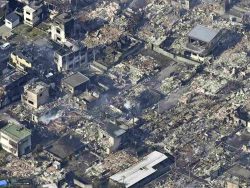
Fire Damages 170 Buildings in Oita, Western Japan
-

Tatsuya Nakadai, Japanese Actor, Dies at 92; Appeared in Films Including “The Human Condition” and “Ran” (UPDATE 1)
-

M5.7 Earthquake Hits Japan’s Kumamoto Pref., Measuring Upper 5 Intensity, No Tsunami Expected
-

Beloved Cat Stationmaster Nitama in Wakayama Pref. Passes Away at 15
-

No Easy Fix for Tokyo’s Soaring Real Estate Prices
JN ACCESS RANKING
-

Govt Plans to Urge Municipalities to Help Residents Cope with Rising Prices
-

Essential Services Shortage to Hit Japan’s GDP By Up to ¥76 Tril. By 2040
-

Japan Prime Minister Takaichi Vows to Have Country Exit Deflation, Closely Monitor Economic Indicators
-

Japan to Charge Foreigners More for Residence Permits, Looking to Align with Western Countries
-

Japan GDP Down Annualized 1.8% in July-Sept.






